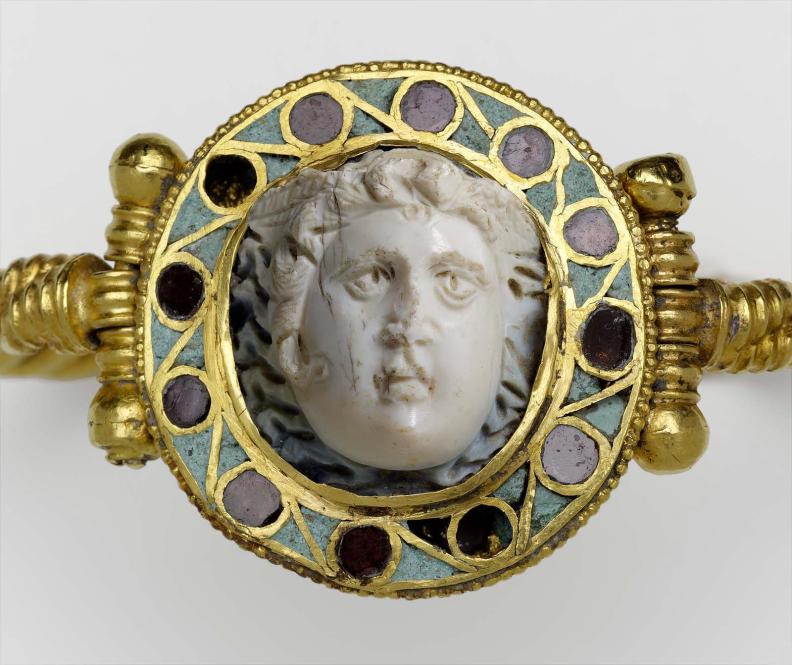
Object Title
Early Byzantine bracelet with a Roman cameo of Medusa
Measurements
Overall: 4.1 x 7.3 cm (1 5/8 x 2 7/8 in.)
Creation Date
5th century A.D., incorporating a cameo of the 1st-2nd centuries A.D.
Credit Line
Gift of George D. and Margo Behrakis
Museum Name
Museum Contact
provenance@mfa.org
Culture
Country of Origin
Object Type
Materials / Techniques
Object URL
https://collections.mfa.org/objects/515106/
Museum's Definition of Antiquity
Before 752 A.D.
Provenance Information
By 2007, Theodore Sarmas (b. 1938 – d. 2018), London; 2008, sold by Theodore Sarmas, through Robert Haber and Associates, New York, to George and Margo Behrakis, Tewksbury, MA; 2022, gift of George and Margo Behrakis to the MFA. (Accession Date: June 22, 2022)
ADDITIONAL INFORMATION:
In 2008, this bracelet was purchased with the guidance of the Museum. The owner, Theodore Sarmas, provided documentation to the MFA that lists “a bracelet” along with trays, brooches, belts, crosses, and “other various items” that his father had acquired in 1937 from a Liverpool collector, Mr. Barry, and that were passed along to Mr. Sarmas at his father’s death in 1963. With this documentation, the MFA accepted the bracelet as a promised gift.
New information has come to light, suggesting that this was a false provenance used repeatedly by the seller. The story may have been fabricated to disguise a recent instance of archaeological looting. Normally, the MFA would not accept or hold an object believed to have been illicitly excavated without reaching out to representatives of the country of origin. In this case, however, the bracelet’s country of origin is not known. By drawing attention to its lack of provenance, the MFA hopes to increase the visibility of the bracelet, raise awareness of the problem of unprovenanced antiquities on the market, and bring in additional information from others.
ADDITIONAL INFORMATION:
In 2008, this bracelet was purchased with the guidance of the Museum. The owner, Theodore Sarmas, provided documentation to the MFA that lists “a bracelet” along with trays, brooches, belts, crosses, and “other various items” that his father had acquired in 1937 from a Liverpool collector, Mr. Barry, and that were passed along to Mr. Sarmas at his father’s death in 1963. With this documentation, the MFA accepted the bracelet as a promised gift.
New information has come to light, suggesting that this was a false provenance used repeatedly by the seller. The story may have been fabricated to disguise a recent instance of archaeological looting. Normally, the MFA would not accept or hold an object believed to have been illicitly excavated without reaching out to representatives of the country of origin. In this case, however, the bracelet’s country of origin is not known. By drawing attention to its lack of provenance, the MFA hopes to increase the visibility of the bracelet, raise awareness of the problem of unprovenanced antiquities on the market, and bring in additional information from others.
Exhibition Information
"Past is Present: Revival Jewelry," MFA, Boston, February 14, 2017 - August 19, 2018.
Publication Information
Yvonne .J. Markowitz, Artful Adornments: Jewlery from the Museum of Fine Arts, Boston (2011), p. 57.
Section of the AAMD Guidelines relied upon for the exception to 1970
Informed judgement that works were outside of the country of modern discovery before 1970
Explain why the object fits the exception set forth above
At the time this was acquired, its provenance was believed to be traceable to a date earlier than 1970. The MFA has since uncovered new information that casts doubts on this account of its ownership history.